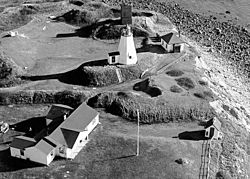Fort Andrew facts for kids
Quick facts for kids Fort Andrew/Gurnet Fort |
|
|---|---|
| Gurnet Point, Plymouth, Massachusetts | |

Fort Andrew's earthworks and Plymouth Light
|
|
|
Location in Massachusetts
|
|
| Coordinates | 42°00′19″N 70°35′58″W / 42.005172°N 70.599517°W |
| Type | Coastal defense |
| Site information | |
| Owner | private |
| Controlled by | US Coast Guard |
| Open to the public |
seasonal with lighthouse |
| Condition | earthworks remain |
| Site history | |
| Built | 1776 |
| In use | 1776–1869 |
| Materials | earthworks |
| Battles/wars | American Revolutionary War War of 1812 American Civil War |
Fort Andrew is an old fort built on Gurnet Point in Plymouth, Massachusetts. It was first known as Gurnet Fort and was built in 1776 for the American Revolutionary War.
The fort became a federal fort and was rebuilt in 1808. It was rebuilt again in 1863 during the Civil War, when it received its current name, Fort Andrew. It is named after John A. Andrew, who was the governor of Massachusetts from 1861 to 1866. In 1863, another fort, Fort Standish, was built nearby. After the Civil War, the government stopped using Fort Andrew for military purposes in 1869. The land was sold in 1926 and became mostly private property. However, the US Coast Guard still uses part of it for a light station.
A World War II fire control tower was built on the old fort's walls. The Plymouth (Gurnet Point) lighthouse is also on Gurnet Point. It was moved inside the fort's earthworks in 1997–1998 to protect it from coastal erosion.
Contents
Fort Andrew's Story
Building the First Fort
Gurnet Fort was built in 1776 during the American Revolutionary War. The state of Massachusetts decided to build it on June 3, 1776. The fort had six cannons and a group of 60 soldiers. Almost half of these soldiers came from nearby Duxbury.
The cannons were smoothbore guns, meaning their insides were smooth. They included three 12-pounders, two 9-pounders, and one 6-pounder. The "pounder" number tells you the weight of the cannonball they fired. The lighthouse on Gurnet Point was actually built earlier, in 1768.
In 1776, a British warship named HMS Niger briefly fought with Gurnet Fort. The ship was looking for American privateers. Privateers were private ships that were allowed by the government to attack enemy ships. During the fight, Niger got stuck in the sand but was soon able to float again. One of the two beacons of the Plymouth Light was destroyed, but no one else was hurt.
Rebuilding for New Wars
Gurnet Fort was rebuilt in 1808 with five cannons. This was part of a plan to improve coastal defenses across the United States. The fort was mentioned in government reports in 1808 and 1811. In 1808, it was noted that "the old work on Gurnet head, near Plymouth, has been repaired." By 1811, the report said the "old fort has been repaired with stone and sods, mounting five heavy guns."
The fort was rebuilt again during the War of 1812. Some sources say it was made to hold very large 42-pounder cannons, which were the biggest the United States had at that time.
The Civil War Era
In 1863, during the American Civil War, the fort was rebuilt once more and renamed Fort Andrew. Major Charles E. Blunt of the United States Army Corps of Engineers designed and oversaw this work. The fort was designed to hold four cannons, with space for three more. It also had a bomb shelter to protect soldiers and two magazines to store gunpowder and ammunition.
The seven cannons installed during the Civil War included four eight-inch smoothbore cannons. There were also three 32-pounder rifled cannons. Rifled cannons have grooves inside their barrels, which make the cannonball spin and fly more accurately. An eighth, smaller cannon, possibly a 6-pounder field gun, was also at Fort Andrew.
How the Fort Land Was Used
The government bought the land for Fort Andrew in two parts, in 1808 and 1870. The total area was about 11.9 acres (4.8 hectares). In 1927, the War Department gave the property to the U.S. Department of the Treasury. This was so it could be used as a US Coast Guard Station.
Before the government bought the land, we don't know much about how it was used. Today, the area includes homes, a Coast Guard facility, and the lighthouse. In 1863, when the military rebuilt the fort, they placed seven coastal defense weapons there. By 1867, an extra small cannon was added, but it was removed by 1880. Records don't show much about the fort's use after 1880. The War Department kept a small part of the land, about 1.7 acres (0.7 hectares), to build a fire control tower during World War II.
Fort Andrew Today
The historic lighthouse still stands within the fort's original earthworks. The World War II fire control tower was taken down sometime after the war. Fort Andrew is not always open to the public. You can usually visit it only during special seasonal open houses at the lighthouse.



